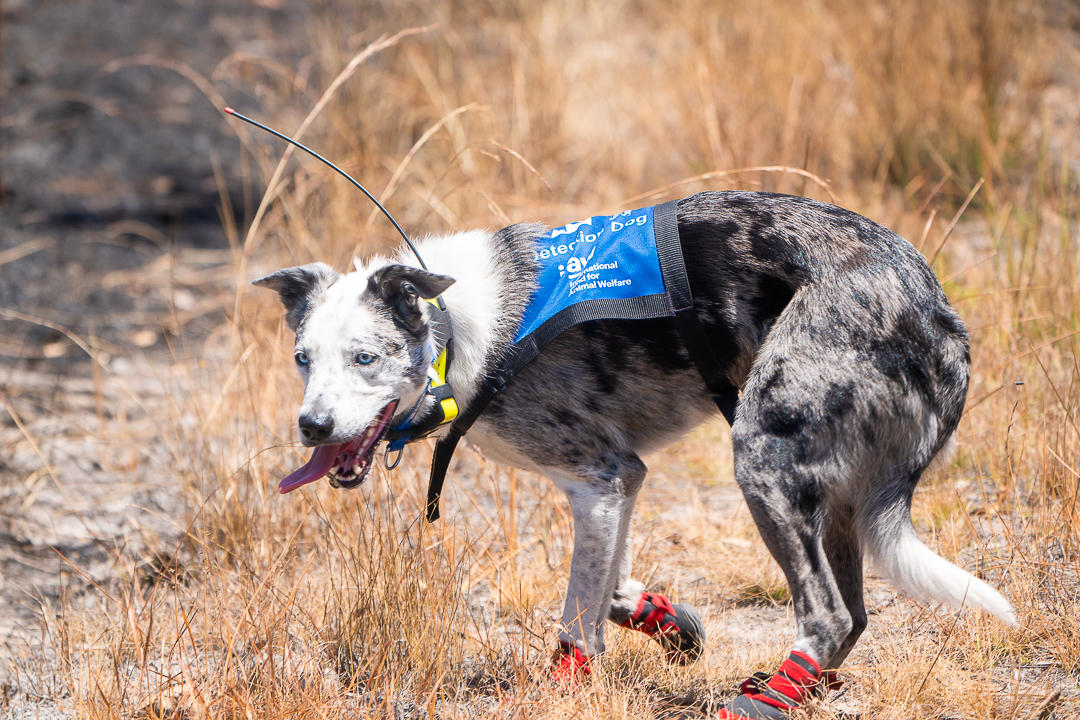Koala Habitat Protection with Detection Dogs – Australia
In Australia, detection dogs are a koala’s best friendBear, ifaw’s koala detection dog, deployed to locate animal survivors in the wake of NSW bushfires
Bear, ifaw’s koala detection dog, deployed to locate animal survivors in the wake of NSW bushfires

Thousands of koalas are feared to have perished in the devastating bushfires still raging across the state, leaving populations at tipping point.
Koalas are particularly vulnerable to bushfires as they are slow moving and live in eucalyptus trees that burn quickly and intensely. When fires sweep through their homes, they often don’t have time to escape and can be incinerated, particularly in intense crown fires that rage through the tree tops where they live.
Koalas can survive for weeks after a fire, suffering from burns and smoke inhalation as they try to escape up trees. Many are still out there in inaccessible areas or active fire-grounds with their homes and food sources destroyed.
Search and rescue teams are trying to locate survivors, but it is a huge challenge. Camouflaged high in the tree tops, koalas are difficult for the human eye to spot. This is where the skills of Bear, IFAW’s koala detection dog, come in.
Bear is part of a team at the Detection Dogs for Conservation Centre at the University of the Sunshine Coast and is trained to detect live koalas through the scent of their fur. Bear is a rescue dog, like all of the dogs at the centre - his obsessive nature and tireless energy made him an unsuitable pet, but also made him the perfect detection dog.
On Friday, Bear and his handler Riana joined a search and rescue effort in the Northern Rivers region with our partners Friends of the Koala. We searched an Indigenous Protected Area, Ngunya Jargoon, which had been devastated by the two fires that swept through over the past month.
Senior Indigenous Ranger Grant Rhodes, whose team protects this biodiversity and cultural hotspot, kindly guided us around the site with local koala researcher and rescuer Maria Matthes. The 1,000 hectare area of woodlands, rainforest and eucalypts forms a vital corridor where an estimated 20-40 koalas live. Up until the fires, this area presented a refuge and a lifeline for iconic species impacted by nearby development. Now it is a blackened, smoldering crematorium with 85% of it burned.
Grant and Maria already helped save two koalas from the aftermath of the fire. The survivors, named Jalu and Kajika, are undergoing rehabilitation with Friends of the Koala. Kajika is currently in the expert hands of IFAW-sponsored vet nurse Marley Christian at Friends of the Koala and is expected to be released soon once a suitable site is located.
Maria recently spotted three more survivors, including a young koala with minor burns in a tree. She set a trap but unfortunately he escaped. So we brought in Bear to help.
With winds up to 30km, the conditions were not ideal for Bear’s tracking, but he indicated possible koalas at a number of spots. Thanks to Bear’s work, we know that there are live koalas in the area and we will continue to search to rescue any koalas who need our help.
-Josey Sharrad, Wildlife Campaigner
We thank the Nyangbul people of the Bundjalung nation for kindly inviting us onto their land. We acknowledge the Traditional Owners of country throughout Australia and recognise their continuing connection to land, waters and culture. We pay our respects to their Elders past, present and emerging.
Related content
Every problem has a solution, every solution needs support.
The problems we face are urgent, complicated and resistant to change. Real solutions demand creativity, hard work and involvement from people like you.